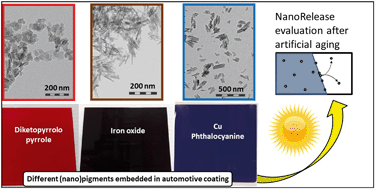Environmental release from automotive coatings are similar for different (nano)forms of pigments†
Abstract
One of the main uses of nanomaterials (NMs) is as functional fillers embedded in solid matrices, such as plastics, tires and coatings. Such products, named nano-enabled products (NEPs), are widely manufactured and employed. However, the risk assessment of NEPs can be very challenging for industries and regulatory agencies because each NM can display great dissimilarities in their physicochemical properties (e.g. size, surface area, crystalline phase, surface chemistry, impurity content). To comply with the current and future nanosafety requirements, an excessive number of case-by-case studies should be performed for a large number of nanoforms. To achieve a cost-efficient risk assessment approach, it is crucial to define a grouping strategy for NMs. In this work, we evaluated the nanoparticle release, after aging, from two typical automotive coatings (acrylic and melamine coatings), incorporating three widely used (nano)forms of pigments (diketopyrrolopyrrole, Cu-phthalocyanine and iron oxide). The results of this study show how different characteristics of the pigments marginally influence the particle emission and the degradation of the coating, supporting a grouping strategy for NMs sharing the same matrix and intended use.



 Please wait while we load your content...
Please wait while we load your content...